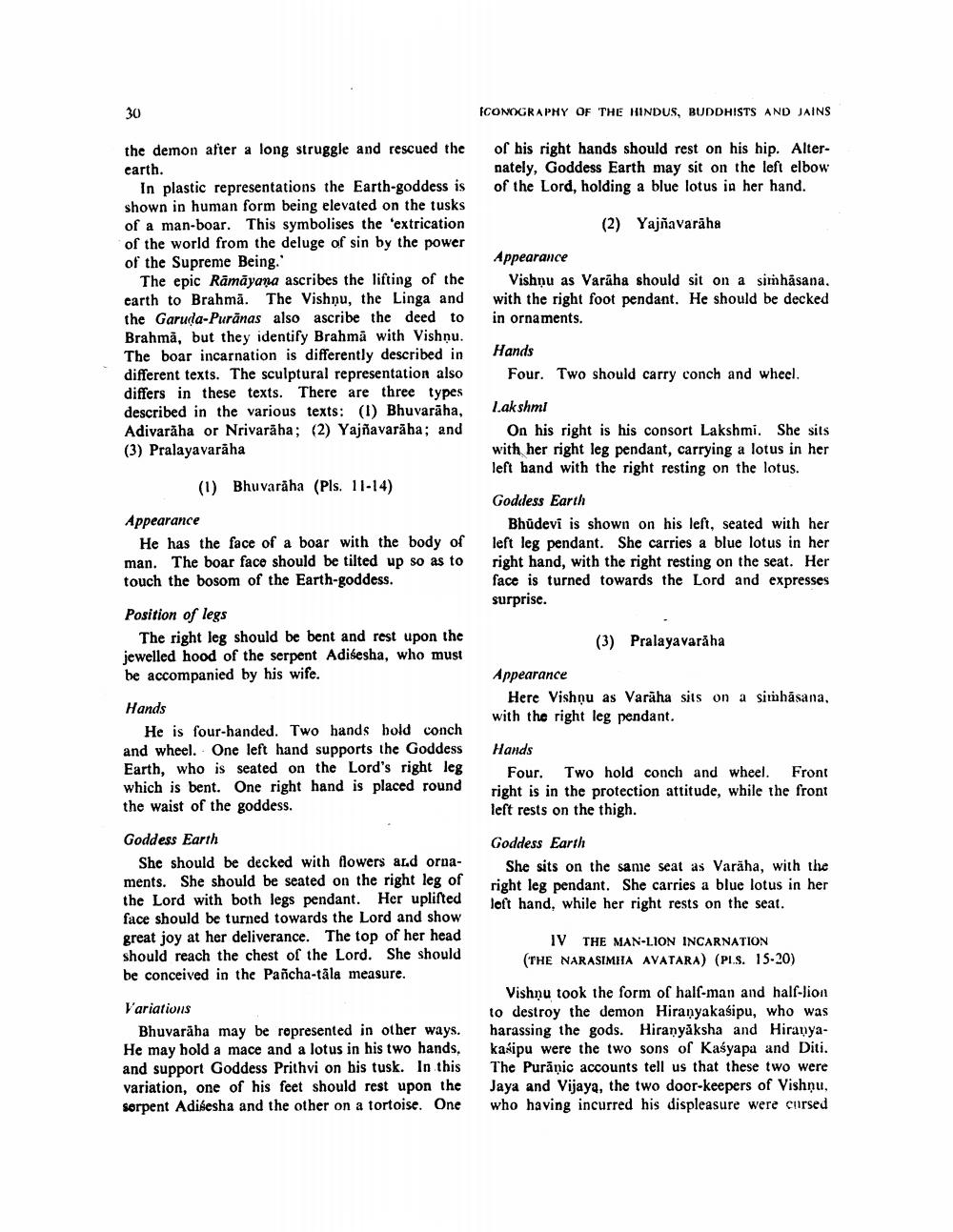________________
30
the demon after a long struggle and rescued the earth.
In plastic representations the Earth-goddess is shown in human form being elevated on the tusks of a man-boar. This symbolises the 'extrication of the world from the deluge of sin by the power of the Supreme Being."
The epic Rāmāyaṇa ascribes the lifting of the earth to Brahma. The Vishnu, the Linga and the Garuda-Puranas also ascribe the deed to Brahma, but they identify Brahma with Vishnu. The boar incarnation is differently described in different texts. The sculptural representation also differs in these texts. There are three types described in the various texts: (1) Bhuvaraha, Adivaraha or Nrivaraha; (2) Yajñavarāha; and (3) Pralayavaraha
(1) Bhuvaraha (Pls. 11-14)
Appearance
He has the face of a boar with the body of man. The boar face should be tilted up so as to touch the bosom of the Earth-goddess.
Position of legs
The right leg should be bent and rest upon the jewelled hood of the serpent Adisesha, who must be accompanied by his wife.
Hands
He is four-handed. Two hands hold conch and wheel. One left hand supports the Goddess Earth, who is seated on the Lord's right leg which is bent. One right hand is placed round the waist of the goddess.
Goddess Earth
She should be decked with flowers and ornaments. She should be seated on the right leg of the Lord with both legs pendant. Her uplifted face should be turned towards the Lord and show great joy at her deliverance. The top of her head should reach the chest of the Lord. She should be conceived in the Pañcha-tala measure.
Variations
Bhuvaraha may be represented in other ways. He may hold a mace and a lotus in his two hands, and support Goddess Prithvi on his tusk. In this variation, one of his feet should rest upon the serpent Adisesha and the other on a tortoise. One
ICONOGRAPHY OF THE HINDUS, BUDDHISTS AND JAINS
of his right hands should rest on his hip. Alternately, Goddess Earth may sit on the left elbow of the Lord, holding a blue lotus in her hand.
(2) Yajnavaraha
Appearance
Vishnu as Varaha should sit on a simhasana. with the right foot pendant. He should be decked in ornaments.
Hands
Four. Two should carry conch and wheel.
Lakshmi
On his right is his consort Lakshmi. She sits with her right leg pendant, carrying a lotus in her left hand with the right resting on the lotus.
Goddess Earth
Bhudevi is shown on his left, seated with her left leg pendant. She carries a blue lotus in her right hand, with the right resting on the seat. Her face is turned towards the Lord and expresses surprise.
(3) Pralayavaráha
Appearance
Here Vishnu as Varaha sits on a simhasana, with the right leg pendant.
Hands
Four. Two hold conch and wheel. Front right is in the protection attitude, while the front left rests on the thigh.
Goddess Earth
She sits on the same seat as Varaha, with the right leg pendant. She carries a blue lotus in her left hand, while her right rests on the seat.
IV THE MAN-LION INCARNATION (THE NARASIMHA AVATARA) (PL.S. 15-20)
Vishnu took the form of half-man and half-lion to destroy the demon Hiranyakasipu, who was harassing the gods. Hiranyaksha and Hiranyakasipu were the two sons of Kasyapa and Diti. The Puranic accounts tell us that these two were Jaya and Vijaya, the two door-keepers of Vishnu, who having incurred his displeasure were cursed




